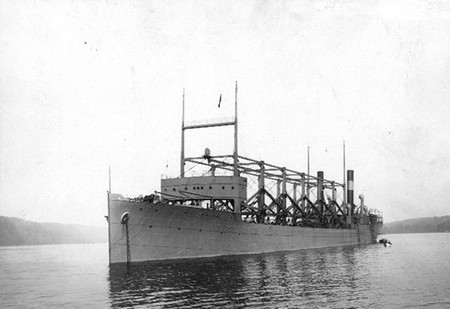Disappearance of USS Cyclops
USS Cyclops was a massive carrier ship and supplied fuel to the American fleet during the World War-I. The 522-foot Cyclops displaced 12,000 tons of water. On January 8, 1918, the ship started sail from the snow covered Norfolk navy port towards Rio of Brazil under the command of Lt. Commander Worley. The ship was only a few years old. The purpose of this voyage was to unload coal at Rio and load Manganese ores used mainly for making steel.
On January 28, the ship reached Rio. It would now dock here for two weeks. And as planned, large amount of coal was unloaded and then 10,000 tons of Manganese ores were loaded into the ship. So the ship was heavy and full.
USS Cyclops anchored on Hudson River in 1911
On the day of its departure, surprisingly some 73 local sailors were asked to board the ship. And more surprisingly, the American Consulate General of Rio, Gottschalk also boarded the ship. When asked, he mentioned that he wanted to enlist his name in the US army to serve the nation during the war.
USS Cyclops then set sail again on February 16th with 309 persons on board and huge load of cargo. It was homebound for Baltimore via Bahi. Now there was another odd turn to the story. After the ship left Bahi, instead of sailing straight towards Baltimore, the captain took it to Barbados in West Indies on March 3rd. He said that they needed more fuel and supplies. Although the US Consul General in Barbados did not feel the necessity of loading more coal and supplies, but the captain insisted, and it was finally done.
On March 4th, Cyclops set sail again and was scheduled to reach Baltimore on March 13th. But... it was never heard of again. When the ship did not reach Baltimore as scheduled, a massive search was initiated soon along her whole course.
Every naval ship from Cuba to Puerto Rico searched for any possible debris anticipating that it might had fallen pray to German Submarines. However, there was no trace of Cyclops.
So, what happened to USS Cyclops?
There are many theories, but none could prove it with real facts and evidence. Even after some 15,000-page report from the US Navy probing the Cyclops mystery, most explanations have still remained as speculations. Strangely, the ship was right in the middle of Bermuda Triangle when the incident had supposedly taken place. Until now this disappearance has remained as one of the greatest mysteries of the ocean... and that is probably because, the wreck of the ship has not yet been located and as a result, the cause is also unknown.
Here are some explanations that come close to what may actually have happened on the sea:
The Captain Worley used to be hated by most of his fellow staffs and officers. They always accused him to be a pro-German. It was actually found out later that Captain Worley was a German born and had a different name earlier. It is not known what caused him to change his name. Also Gottschalk, the US Consulate General of Rio, who surprisingly boarded the ship along with 73 other local sailors, was also very popular among the German community in Brazil.
Moreover, lot more coal and fuel were loaded from Barbados when it was not officially planned or even required. So was it a case of Sabotage? Why was there no SOS call made by the captain. Since the US war with Germany already broke out by then, did the captain and Gottschalk connived and sunk the ship or destroyed it? Or taken it all the way to Germany?
Here is another theory. One of the navy officers, Nervig was onboard the Cyclops till Rio. He wrote a report that he often found the deck of the ship swaying when large waves struck the ship. So the ship was already showing signs of weakening and getting split. So there may had been a structural failure that sunk the ship.
Another report says that on its sail from Rio, Cyclops was overloaded with Manganese plus fuel and many persons aboard. The load was more than the ship was designed to handle. A heavy mid oceanic storm had hit the ship and it overturned, cargo scattered and it all sank to the bottom of the ocean.
Was the ship blasted by a German underwater mine or torpedoed by a German Sub? US Navy claims that such possibility does not exist if the ship had been on its right course. However, had the ship been off its track by a large margin, there was a high possibility of that to happen and the ship would have perished.
|
 By Raj Bhattacharya By Raj Bhattacharya
Raj, a seasoned travel writer and Bermuda destination expert, has extensive global travel experience. This website reflects his profound insights, garnered over nearly two decades of dedicated findings and research on the island. Raj has assisted countless Bermuda-bound visitors by providing direct, personalized responses to their queries and imparting his wealth of knowledge through this platform. This site serves as an indispensable guide for those seeking informed and reliable insights into Bermuda's treasures.
|
Related Articles
|
Your Reviews and Comments
Lord Kwll (December 2022)
After reading through the theories put forth in this article, I have to say that none of them explain why the wreckage of the ship has not been located to this day. Its course was known and could be re-traced with sonar and understand imaging, which could surely turn up where it is. Manganese ore has been thought to be a very dangerous cargo because it grinds through holds if it shifts and this could have caused problems, as could the reported coal fire the ship had suffered before coming into Barbados, but both still leave the same question unanswered. One more theory involves the fact that the ship also took on a number of prisoners in Barbados. A mutiny and the possible scuttling of the ship could come into play there, but even then, the ship would still be at the bottom of the sea, somewhere along its track in all likelihood or not far from it. Case closed doesn't mean case solved at any rate.
Don Snyder (June 2021)
One could argue that the Cyclops could have encountered a German mine or torpedo. I find that theory lacking, because no debris were ever found. Being overloaded with manganese ore, fuel and a shocking number of crew/passengers, it is possible that a storm or rogue wave could have shifted the ore, compromising the hatch covers.
James W. DuVall (July 24, 2015)
The USS Cyclops was un-seaworthy, lost power and with it the power to operate and drive the pumps that were keeping her afloat. She was broadside, in a rough sea and swamped. Thus, lost with all hands. No little green men, just a massive cover up.
|

 By Raj Bhattacharya
By Raj Bhattacharya